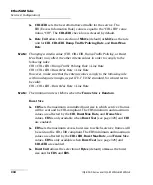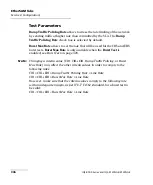
EtherSAM Tabs
328
IQS-8500 Series and IQS-8120NGE/8130NGE
Overview (Configuration)
In the third stage of the test, when the
Ramp Traffic Policing Rate
check box is enabled, the throughput will be increased one step
over the CIR+EIR if enabled otherwise over the CIR to compare
against expected maximum throughput threshold to declare a
pass/fail verdict.
The ramp test procedure is generated for each enabled service.
The
Ramp Test
check box is selected by default.
Burst Test
The objective of the burst test is to verify that the expected burst
size can be transmitted at maximum burst rate with minimal loss.
CBS (Committed Burst Size), when enabled, verifies the
performance of a committed burst size at CIR’s average TX rate.
EBS (Excess Burst Size), when enabled, verifies the performance
of an excess burst size at CIR+EIR’s average TX rate.
The maximum Jitter, Latency, Frame Loss, and throughput are
measured. For CBS, the Jitter, Latency, and Frame Loss will be
compared to the SLA thresholds to declare a pass/fail verdict. For
EBS, the throughput will be compared to the SLA thresholds to
declare a pass/fail verdict.
The burst test procedure is generated for each enabled service.
The
Burst Test
check box is cleared by default.
Service Performance Test
The objective of this test is to verify that the SLA parameters are met
over time by running multiple services simultaneously. The maximum
Jitter, Latency, Frame Loss, sequence, and average throughput are
measured and will be compared to the configured thresholds to
declare a pass/fail verdict. The
Service Performance Test
is not
performed for services that have their CIR check box cleared. The
Service Performance Test
check box is selected by default.
















































